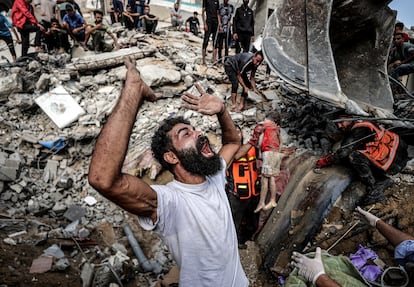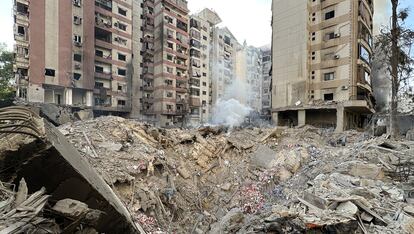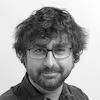The Middle East, a year of horror with more conflict on the horizon
The anniversary of the October 7 Hamas attacks comes as the region faces its most dangerous moment in decades, awaiting Israel’s retaliation for Iran’s attack and its unforeseeable consequences and while bombs continue to fall on Lebanon, which has taken the spotlight from Gaza

One year ago, Shaylee Atary was fleeing from the gunfire, in her pajamas and with her baby in her arms, in Kfar Aza, her kibbutz next to Gaza, while imagining that this was not really happening to her. That on October 7, 2023, she — a filmmaker by profession — was not facing a situation that defied reality, but rather had shouted “action!” the moment the Hamas surprise attack woke her up and she asked her husband, Yahav Winner: “Honey, are we going to die today?” “I promise you we won’t,” he replied.
Then they heard the first shots. She grabbed the baby, he tried to block the door and they saw the light of dawn coming in: the militiamen were forcing open the window. “There was no time, but he turned to me and looked at me in a way that said ‘goodbye. ’” He was left struggling with them and she ran through the kibbutz, not realizing — until she heard a nearby tree hit — that “the buzzing I heard was bullets.” After knocking on the doors of houses where they thought she was a terrorist and hiding in a storage room, she ended up hiding with some neighbors. Atari, then 34 years old, and her one-month-old baby were only able to breathe 27 hours later. “People often ask me if it was difficult to spend 27 hours without eating or drinking, in fear. For me, hell was spending 27 hours humming lullabies to my baby so she wouldn’t cry, so we wouldn’t be discovered, while I was realizing what my gut was telling me: that my husband was dead and my life had just changed completely.”
She tells the story in Yaffa, near Tel Aviv, in a house lent to her by a friend, above all, so she could take a break from the pitying glances: her husband became one of the nearly 1,200 victims on the deadliest day in Israel’s history, which has led to the most insecure, explosive and unpredictable situation in the Middle East in decades. The world is waiting for something that — like Atary’s perception of the Hamas attack — would have seemed like something from a movie a year ago: Israel’s “serious and significant” retaliation for Iran’s second direct attack in a year, a move that would further inflame the region and lead to unforeseeable consequences.
Two days after Atary escaped death, Israeli Prime Minister Benjamin Netanyahu gravely uttered a sentence that went almost unnoticed and is more meaningful today than ever: “We are going to change the Middle East. This is only the beginning.” Five days later, Israeli President Isaac Herzog — a politician considered moderate from the Labor Party — argued that all of Gaza was to blame for the Hamas attacks. “It is an entire nation out there that is responsible,” he said. “It is not true this rhetoric about civilians not being aware, not involved. It’s absolutely not true.” At that point, the Israel Defense Forces (IDF) had already dropped 6,000 4,000-ton bombs on Gaza (almost the same number as the U.S. dropped in Afghanistan in an entire year) and an average of 15 people were dying every hour.
It has been a year of horror. Both with respect to the stories and the numbers. In Gaza: more than 42,000 dead, mostly women and children; practically the entire population displaced (several times, in most cases) and a humanitarian crisis created by Israel as a tool of war to exert pressure. What sparked outrage has ended up becoming routine, such as the bombing of schools that house displaced people, the raids on medical centers or orders to move the population. The latest of which was issued on Saturday.

H. is one of the Israeli soldiers who fought in Gaza. He withheld his name, his battalion and the details of his conversations with his superiors so that he could speak freely about what he did and saw, such as the use of Palestinian civilians as human shields. They didn’t call it that, but rather the “mosquito procedure,” but everyone understood what it consisted of: taking two arrested people and taking them, handcuffed and blindfolded, to search homes. They let them go in first, so that they (and not the soldiers) would die if an ambush or booby traps awaited them.
H. says that he forced a teenager to open doors and windows for hours. That they only removed his blindfold to open the doors and he looked terrified. And that his superior released them after the searches. “That's when I understood that they had lied to me and said they were terrorists. If they were, we wouldn't have let them go,” he says.
He also talks about the wanton burning of empty Gazan homes, which Israeli soldiers themselves boast about on social media. “They told us to burn every house where there was a Hamas sign, like a flag. And Hamas was the main power in Gaza, so most of them had one, or a picture of [Ismail] Haniyeh [the Hamas leader, killed by Israel in July]. Even if there was a picture of Yasser Arafat or a Fatah flag, the commander told us to burn it.” When asked how many, he replies: “A lot. 20 or so […] Also, since the fire goes up, in multistory buildings, we had to start at the top and then go down the floors.” Two soldiers in their platoon did this, with oil or fuel that they brought into the house, forming a pyre with sofas and mattresses.
“They were not ideologically fanatic soldiers who wanted to do harm. They just had fun. When you spend a lot of time in Gaza, you stop thinking about the fact that there are people who will live there in the future […] From a certain point on, what you feel is mostly apathy,” he says.
What he is describing can be easily found on the internet. This is one of the peculiarities of the past year. Israel prevents the international press from freely entering Gaza. It only allows Israeli media and some foreign media to be embedded with foreign troops, privileging outlets closest to the government ideologically. However, there is no shortage of images. They are provided by Palestinian journalists on the ground (never before so many have died in a conflict, 130) and by the Israeli and Gazan military themselves, both militiamen and civilians, with their cell phones.
Opening a safe to steal money, making fun of women’s underwear, burning houses, opening fire aimlessly, dedicating controlled explosions of houses or a university to relatives, smashing cars for fun... Israeli soldiers post photos and videos without realizing that what their own people applaud (as a sort of collective redemptive revenge for the massacre of October 7) could end up as evidence in the genocide case at the International Court of Justice in The Hague. The Israeli army itself went so far as to release to the media an aerial view of two young men walking peacefully before they died in an air attack, as proof that they were carrying grenade launchers. It ended up admitting that they were bicycles.
Israel is no safer today either. Its population remains united around the idea that the problems that violence has not solved are because it has not been used enough. The country largely supports the endless flight forward by Netanyahu, who has regained his scepter in the polls thanks to the assassinations of leaders of Hamas and Hezbollah.
Despite life in Israel continuing relatively normally, the country is facing an unprecedented and challenging situation. A year on, 67,000 people remain evacuated from the north, while more than 100 hostages are still held in Gaza. Hezbollah continues to launch 200 rockets daily, with missiles flying over Tel Aviv, and reservists are being called up two to three times in pursuit of Netanyahu’s promise to achieve “total victory” and a “new order” in the Middle East. A recent attack in Yaffa claimed seven lives.
Longest conflict ever
Never before, not even in the three wars between Israel and the Arab countries, has a conflict lasted so long. Nor have so many of Iran’s allies become involved. The Houthis in Yemen have obstructed maritime traffic and launched drones and missiles at Israeli cities such as Tel Aviv and Eilat. Militias in Iraq recently killed two soldiers in the Golan Heights.
In Beirut, Netanyahu’s attempt to reshape the Middle East has forced Goussun, a 41-year-old Lebanese woman, to sit on the pavement below her house in Al Manara, one of the most exclusive areas of the city. She lives in an area that is not one of Israel’s target, but she heard a rumour on WhatsApp that the building next door was going to be bombed and she still doesn’t dare return with her two cats and the family of displaced people from the south that she is hosting. “You never know if the message is true or false... I also have no way of verifying it. I don’t feel safe anywhere anymore. Look at what happened in Cola [the first Israeli bombing of the offensive in central Beirut]. I am overcome with fear. It is no longer contained to Dahieh [the southern suburb of the Lebanese capital that is a Hezbollah stronghold].”

IDF spokesman Daniel Hagari has insisted that Israel’s offensive will not reach Beirut, but will consist of “limited, localized and targeted raids” in southern Lebanon that will last just long enough for evacuees from the north to return to their homes. The official aim was similar in 1982 (the unofficial one was also to place the leader of the Lebanese Phalanges, Bachir Gemayel, in power). That’s when Israel launched Operation Peace for Galilee against the militants of the Palestine Liberation Organization. With Ariel Sharon as defense minister, the troops surrounded Beirut. They only withdrew after a mass demonstration in Tel Aviv (an event like that would take everyone by surprise today) in protest against Israel’s Christian allies’ complicity in the massacre carried out in the Palestinian refugee camps of Sabra and Chatila. Sharon resigned, and the operation that was supposed to last a short time ended in 18 years of occupation of southern Lebanon.
“I promised,” Netanyahu said two weeks ago, after the deadliest day (558 dead) in Lebanon’s history since the civil war (1975-1990), due to a wave of Israeli bombings, “that we would change the security balance” with Hezbollah. “We are winning,” said the Israeli prime minister, who feels buoyed by the pager and walkie-talkie attacks in Lebanon; the historic assassination of Hezbollah leader Hassan Nasrallah and most of its military leadership; and the laissez-faire attitude of U.S. President Joe Biden.
Israel is continuing to pursue its strategy of eliminating Hezbollah leadership: on Friday, an attack supposedly killed the foreseeable new leader of the Shiite militia, Hashem Safieddine. It is the Gaza-ification of Lebanon. In the three weeks since the offensive began, the death toll has surpassed 1,400, and 1.2 million people have been displaced. Around 200,000 have fled to Syria, while tens of thousands of Gazans have paid large sums to escape to Egypt.
On Tuesday, the prospect of a war between Israel and Iran became more likely. Iran launched nearly 200 missiles at Israel, sending a message to its allies, who had felt abandoned and even betrayed. As in April — when Iran carried out its first direct retaliation against Israel, marking another significant event in a year full of Middle Eastern tensions — the ayatollahs’ regime warned intermediaries to avoid provoking a clear casus belli. However, they demonstrated their strength with faster, harder-to-intercept missiles. Iran primarily targeted military sites, and no Israelis were killed. Tehran’s actions were also driven by unresolved tensions following the July assassination of its guest, Ismail Haniyeh.
How did we get here? “This outcome is in many respects the consequence of the Israeli government’s political decisions, in particular its unwillingness to enter into a Gaza ceasefire that all sides — including the U.S., Israel’s key backer — say is ready to be finalized,” write Julien Barnes-Dacey, director of the Middle East and Africa program, and Hugh Lovatt, senior analyst on the region, at the European Council on Foreign Relations think tank. “This should not downplay the destabilizing actions of Hezbollah and its Iranian patron, nor minimize the security threats faced by Israel on its northern border. But it does reflect the reality that current escalatory dynamics are being driven by the Israeli government.”
In this context, it’s unsurprising that the remarks of Jordanian Foreign Minister Ayman Safadi have recently gone viral, following Netanyahu’s bellicose speech at the U.N. General Assembly and his approval of Nasrallah’s assassination via telephone from New York. Safadi represents a nation not typically seen as extremist. Jordan suppresses pro-Gaza protests, viewing them as a threat to its stability, is a steadfast ally of the U.S., and has maintained diplomatic relations with Israel since 1994. Notably, it was the only Arab country to assist Israel in intercepting Iranian missiles last April.
“The Israeli prime minister came here today and said that Israel is surrounded by those who want to destroy it,” said Safadi, visibly upset. “We’re here — members of a Muslim-Arab committee, mandated by 57 Arab and Muslim countries — and I can tell you here, very unequivocally, all of us are willing to, right now, guarantee the security of Israel in the context of Israel ending the occupation and allowing for the emergence of a Palestinian state […] Netanyahu is creating that danger because he simply does not want the two-state solution. And if he does not want the two-state solution, can you ask the Israeli officials: What is their endgame other than just wars and wars and wars?”
Sign up for our weekly newsletter to get more English-language news coverage from EL PAÍS USA Edition
Tu suscripción se está usando en otro dispositivo
¿Quieres añadir otro usuario a tu suscripción?
Si continúas leyendo en este dispositivo, no se podrá leer en el otro.
FlechaTu suscripción se está usando en otro dispositivo y solo puedes acceder a EL PAÍS desde un dispositivo a la vez.
Si quieres compartir tu cuenta, cambia tu suscripción a la modalidad Premium, así podrás añadir otro usuario. Cada uno accederá con su propia cuenta de email, lo que os permitirá personalizar vuestra experiencia en EL PAÍS.
¿Tienes una suscripción de empresa? Accede aquí para contratar más cuentas.
En el caso de no saber quién está usando tu cuenta, te recomendamos cambiar tu contraseña aquí.
Si decides continuar compartiendo tu cuenta, este mensaje se mostrará en tu dispositivo y en el de la otra persona que está usando tu cuenta de forma indefinida, afectando a tu experiencia de lectura. Puedes consultar aquí los términos y condiciones de la suscripción digital.
More information

Thousands of displaced people in Gaza live trapped between bombs and rising tides: ‘We could drown in our sleep’
Three potatoes for $40: The face of hunger in Gaza
Archived In
Últimas noticias
Most viewed
- Reinhard Genzel, Nobel laureate in physics: ‘One-minute videos will never give you the truth’
- Oona Chaplin: ‘I told James Cameron that I was living in a treehouse and starting a permaculture project with a friend’
- Pablo Escobar’s hippos: A serious environmental problem, 40 years on
- Chevy Chase, the beloved comedian who was a monster off camera: ‘Not everyone hated him, just the people who’ve worked with him’
- Why we lost the habit of sleeping in two segments and how that changed our sense of time









































